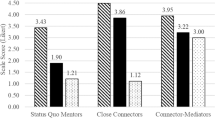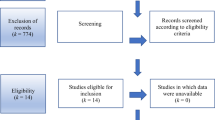Abstract
The use of mentors in social services programs has become an increasingly common intervention, and typically aims to increase education and job skills among at-risk youth. Because of a lack of social services research, most of what is known about the effects of mentoring relationships has been generalized from studies conducted in corporate settings. This article examines assumptions about the potential effects of mentor programs, and presents the results of an exploratory case study of outcomes of low-income teen mothers who were paired with a professionally employed mentor. Drawing on the concepts of social network theory, it is hypothesized that mentors can link at-risk youth with information and resources not readily available from their extant personal networks.
Similar content being viewed by others
References
Alleman, E., & Gray, W. (1986).Design Productive Mentoring Programs. (Info-Line Monograph). Alexandra, VA: American Society for Training and Development.
Blackburn, R., Behmyer, C., & Hall, E. (1978). Correlates of faculty publications.Sociology of Education, 51, 132–141.
Betz, N.E., & Fitzgerald, L.F. (1987). The Career Psychology of Women. San Diego: Academic Press.
Blechman, E.A. (1992). Mentors for high-risk minority youth: From effective communication to bicultural competence.Journal of Clinical Child Psychology, 21(2), 160–169.
Brockman, B. (1992, June). Iowa's volunteer mentor program.Innovations, The Council of State Governments, Lexington, Kentucky, pp. 2–7.
Clawson, J. (1980). Mentoring in managerial carrers. In C. Derr (Ed.), Work, Family, and the Career: New Frontiers in Theory and Research, (pp. 144–165). NY: Praeger.
Clawson, J. (1985). Is mentoring necessary?Training and Development Journal, 39(4), 36–39.
d'Abbs, P. (1982).Social Support Networks. Melbourne, Australia: Institute of Family Studies.
Dean, A., & Lin, N. (1977). The stress-buffering role of social support.Journal of Nervous and Mental Disease, (6), pp. 403–417.
Dreher, George F., & Ash, Ronald A. (1990). A comparative study of mentoring among men and women in managerial, professional, and technical positions.Journal of Applied Psychology, 75(5), 539–546.
Galbo, J.J. (1986). Adolescents' perceptions of significant adults: Implications for the family, the school, and youth serving agencies.Children and Youth Services Review, 8, 37–51.
Garmezy, N. (1985). Stress resistent children: The search for protective factors. In J.E. Stevenson (Ed.),Recent Research in Developmental Psychopathology (pp. 213–223). Oxford, U.K.: Pergamon.
Giles, Harriet Watkins, & Endley, Richard C. (1988). Early career development among child and family development professionals: The role of professor and peer relationships.Family Relations, 37, 470–476.
Granovetter, M. (1973). The strength of weak ties.American Journal of Sociology 78, 1360–1380.
Granovetter, M. (1982). The strength of weak ties: A network theory revisited. In P.V. Marsden & N. Lin (Eds.),Social Structure and Network Analysis (pp. 105–130). Beverly Hills, CA: Sage.
Gray, W. (1986). Achieving employment equity and affirmative action through formalized mentoring. In Conference Proceedings of the National Conference on Management in the Public Sector. Victoria, British Columbia, Canada.
Hammer, M. (1981). Impact of social networks on health and disease. Paper presented to the American Association for the Advancement of Science Symposium, Toronto, Canada.
Henderson, S. (1980). A development in social psychology: The systematic study of social bonds.The Journal of Nervous and Mental Disease, 168(2), 63–69.
Hunt, D.M., & Michael, C. (1983). Mentorship: A career development tool.Academy of Management Review, 9, 475–485.
Kanter, R. (1977). Men and Women of the Corporation. NY: Basic Books.
Keele, R., Buckner, K., Bushnell, S. (1987). Formal mentoring programs are no panacea.Management Review, 76(2), 67–68.
Klauss, R. (1981). Formalized mentor relations for managerial and executive development in the federal government.Public Administration Review, 41, 489–496.
Kram, K. (1980). Mentoring processes at work: Developing relationships in managerial careers. Unpublished doctoral dissertation, Yale University, New Haven.
Kram, K. (1983). Phases of the mentor relationship.Academy of Management Journal, 26, 608–625.
Kram, K. (1985). Improving the mentoring process.Training and Development Journal, 39(4), 40–43.
Kram, K. (1987). Mentoring in the workplace. In D. Hall & Associates (Eds.) Career Development in Organizations (pp. 160–201). San Francisco: Jossey-Bass.
Kram, K. & Isabella, L. (1985). Mentoring alternatives: The role of peer realtionships in career development.Academy of Management Journal, 28, 110–32.
Levinson, D., Darrow, C., Klein, E., Levinson, M., & McKee, B. (1978). Seasons of a Man's Life, NY: Knopf.
Lin, N. (1982). Social resources and instrumental action. In P. Marsden & N. Lin (Eds.),Social Structure and Network Analysis (pp. 131–146). Beverly Hills, CA: Sage.
Missirian, A. (1982). The Corporate Connection: Why Executive Women Need Mentors to Reach the Top. Englewood Cliffs, NJ: Prentice-Hall.
Moore, K. (1982). The role of menotrs in developing leaders for academe.Education Record, 63, 62–68.
National Longitudinal Survey of Youth. (1992). Public use files, compiled by Child Trends, Inc., Washington DC.
Nieva, V.A., & Guteck, B.A. (1981). Women and Work. New York: Praeger.
One to One Partnership, Inc. (1993). Mobilizing for the Next Generation. Washington DC.
One to One Partnership, Inc. (1992). Training curriculum for mentors and youth. Washington DC: National Mentoring Working Group.
Phillips, L. (1977). Mentors and proteges: A study of the career devleopment of women managers and executives in business and industry. Unpublished doctoral dissertation, University of Miami.
Phillips-Jones, L. (1982). Mentors and Proteges. NY: Arbor House.
Phillips-Jones, L. (1983). Establishing a formalized mentoring program.Training and Development Journal, 37(2), 38–42.
Queralt, M. (1982). The role of the mentor in the career devleopment of university faculty members and academic administrators. (Doctoral dissertation, University of Miami, 1981). Dissertation Abstracts International, 43, 693A.
Ragins, B.R. (1989). Barriers to mentoring: The female manager's dilemma.Human Relations, 42, 1–22.
Rawles, B. (1980). The influence of a mentor on the level of self-actualization of American scientists. (Doctoral dissertation, The Ohio State University, 1982). Dissertation Abstracts International, 41, 1348A.
Redmond, S.P. (1990). Mentoring and cultural diversity in academic settings.American Behavioral Scientist, 34(2), 188–200.
Reich, M. (1985). Executive views from both sides of mentoring.Personnel, 62(3), 42–46.
Reich, M. (1986). The mentor connection.Personnel, 63, 50–56.
Reskin, B. (1979). Academic sponsorship and scientists' careers.Sociology of Education, 52, 129–146.
Rhodes, J.E., Ebert, L., Fischer, K. (1992). Natural mentors: An overlooked resource in the social networks of young, African American mothers.American Journal of Community Psychology, 20(4), 445–461.
Roche, G. (1979). Much ado about mentors.Harvard Business Review, 57(1), 14–28.
Rutter, M. (1987). Psychosocial resilience and protective mechanisms.American Journal of Orthopsychiatry, 57, 57–72.
Travers, J., & Milgram, S. (1969). An experimental study of the small world problem.Sociometry, 32, 425,443.
Vaillant, G. (1977).Adaptation to Life. Boston: Little-Brown.
Walker, K.N., MacBride, A., & Vachon, M.L.S. (1977). Social support networks and the crisis of bereavement.Social Science and Medicine, 11, 35–41.
Whitely, W., Dougherty, T.W. & Dreher, G.F. (1988, August). The relationship of mentoring and socioeconomic origin to managers' and professionsals' early career progress.Academy of Management Best Paper Proceedings, pp. 58–62.
Wilson, W.J. (1987).The Truly Disadvantaged. Chicago: University of Chicago Press.
Zey, M. (1984). The Mentor Connection. Homewood, IL: Dow Jones-Irwin.
Zey, M. (1985). Mentor programs: Making the right moves.Personnel Journal, 64(2), 53–57.
Zippay, A. (1990). The limits of intimates: Social networks and economic status among displaced industrial workers.The Journal of Applied Social Sciences, 15(1), 75–96.
Author information
Authors and Affiliations
Rights and permissions
About this article
Cite this article
Zippay, A. Expanding employment skills and social networks among teen mothers: Case study of a mentor program. Child Adolesc Soc Work J 12, 51–69 (1995). https://doi.org/10.1007/BF01876139
Issue Date:
DOI: https://doi.org/10.1007/BF01876139




